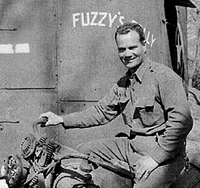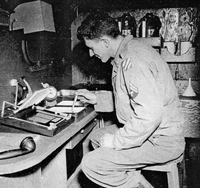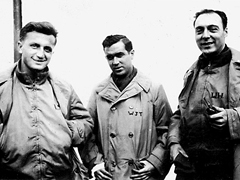|
|
3rd Signal Co. Photography WWII :: U.S. 3rd Infantry Division
»» SMALL SCREEN »» DESKTOP SITE
d o g f a c e s o l d i e r
F u z z y's F o l l y
WWII images from five combat
photographers of the U.S. 3rd Infantry Division
_______________________________________
surf all sections : ANZIO | ROME | DRAGOON
BREAKOUT | MONTELIMAR | VOSGE | STRASBOURG
COLMAR POCKET | RHINELAND | GERMANY | AUSTRIA
_______________________________________

|
|
The story begins at Anzio ...
by Howard Nickelson
 < Jack Cole at Anzio
< Jack Cole at Anzio
FUZZY FEZELL was an officer in the 3rd Signal Company who didn't show up at the company very often, but when he did, things happened. I don't remember his rank but it was better than my corporal, probably a captain. He was known by his officer friends as "Fuzzy" because he didn't have any hair on top, just fuzz on the sides.
Photographic equipment and a method to produce a photo within the division were almost non-existing. When photos were needed, the division had to rely on photographic signal units at the corps level to take them. My outfit, the HQ Co of the 10th Engineers, had a 4x5 Speed Graflex that was part of their equipment, but to develop and print a photo they had to rely on someone else because darkrooms were lacking.
The need for photos was great. Photos taken from L-5 Cub airplanes gave the infantry a photo of the ground they had to take. The division needed these and a fast way to produce photos for its history and many other needs. A photo tells a thousand words — aerial photography especially.
The 3rd Signal Company was blessed with a fine carpenter, Sgt. Edward F. Kazewicz, who could create wheeled-trailers that housed communications facilities better than tents and shelters could. And they were mobile. Kazewicz's trailers were made from battlefield junk, both German and American. Eventually the company had more trailers than trucks. Kazewicz built a darkroom trailer under trying conditions at Anzio and it was christened "Fuzzy's Folly".
Now it was necessary to find a crew to take pictures, develop film and make prints.
The first to be called upon was Sgt. Jack Cole who did the picture taking at the 10th Engineer's HQ including, when called upon, to take photos from the L-5 Cub planes flown by the Artillery Observation Group. Jack was an amateur photographer and he was great in P.R.
 < Howard inside Fuzzy's Folly
< Howard inside Fuzzy's Folly
JACK THEN CALLED upon me. Jack and I were fast friends. I had attended the Montana School of Mines for three years. I was never asked, but I was told, "You are going to the 3rd Signal Company as a photographer." It sure beat making mine signs for posting in the Anzio mine fields. Later, a 10th Engineer Battalion commander told me, "The 3rd Signal Company shanghaied you and Jack."
Later Pvt. William Heller was transferred off a line company of the 15th Regiment. Bill was 35 or 36 years old and spent years as a professional photographer and had his own studio in Chicago. He was known as "Pop" Heller.
Pvt. Bill Toomey came from the 3rd Reconnaissance Company Battle Patrol. He had been a photographer with a newspaper near Boston. Bill was a small man and I don't know how he survived the rigors of the battle patrol. He had very small hands.
The last to come was Pvt. Robert Seesock. I believe he was a recruit off the boat and an amateur photographer. He looked and acted like the all-American boy.
The photo lab was well-equipped. It had an 8x10 contact printer that saw the bulk of the printmaking and the necessary large developing pans that fit by the printer that was built into the cupboard. An enlarger capable of handling 4x5 negatives along with the necessary lights and tools were part of the equipment.
One of the most important items was a Kodak manual that gave us all the information regarding development times et al. It was a bible for us. We had one 4x5 Speed Graflex camera and later obtained an L-5 aerial camera which was hand-operated with roll film and took 4x5 negatives. The L-5 had a fixed focus at 30 feet and beyond. It was a great camera for aerial pictures because it was fast to operate with its hand lever. We also had a decent G.E. light meter. Our own private cameras were used at times when the occasion arose.
 < Seesock, Toomey, and Heller
< Seesock, Toomey, and Heller
THE PHOTO SECTION pulled no guard duty or K.P., and we were always "Fezell's fair-haired boys". We would always bivouac with the 3rd Signal Company.
Most of my time was spent developing film, making prints and captioning prints and negatives. We made five prints for distribution. The developing and printing were under field conditions and temperature played an important role especially when it was hot. When it was below freezing the operation practically stopped as the developing solutions froze. Developer chemistry needed to be five degrees plus or minus of 70 degrees to be effective. Finding and keeping water to wash the film and prints was a problem. Unwashed prints turn yellow.
Jack Cole got the orders and assigned the crew or did it himself. He took a lot of the aerial photography and helped distribute the prints to whoever needed them. Jack rode a motorcycle and we had a jeep. Jack had a gift of gab and women loved him and vice versa.
Bill Heller, I never knew as well but he was a good photographer, married, Jewish and he played some baseball. We corresponded after the war, he had a couple of sons whose pictures were on his Christmas cards. After the war he continued operating his photo store in Chicago.
I did not hear from Bill Toomey or Bobby Seesock after the war.
I don't know what happened to "Fuzzy's Folly", but all the negatives, some 1,300 plus were burned. Sob! Sob! All that great work and history up in flames.
(Ed. note: Nickelson's journey home started on May 2, 1945 in Salzburg Austria. Nickelson had been with the 3rd Division for 33 months; entering combat in Casablanca with the 10th Engineers. This story, a part of his hand-written memoir, appears with his permission and was posted to this website on the 62nd anniversary of the Normandy landings on June 6, 2006.)
(Ed. note: After the war, George Fezell implemented Magnavox's innovative factory-direct business model in the 1950s and became president of the company's consumer electronics division in 1968.)
^ Back to Top
surf all sections : ANZIO | ROME | DRAGOON
BREAKOUT | MONTELIMAR | VOSGE | STRASBOURG
COLMAR POCKET | RHINELAND | GERMANY | AUSTRIA
3rd Sig. Photographers :: HOME PAGE :: Dogface Gallery
Copyright © 2005-2023 Tansi Publishing. All rights reserved.
|
 |
 |
|
|

